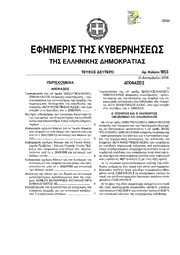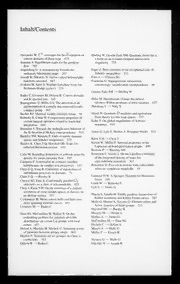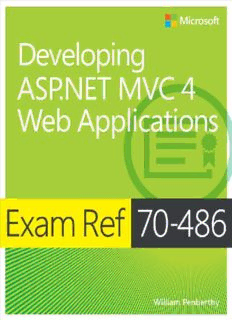
Exam Ref 70-486: Developing ASP.NET MVC 4 Web Applications PDF
Preview Exam Ref 70-486: Developing ASP.NET MVC 4 Web Applications
Exam Ref 70-486: Developing ASP.NET MVC 4 Web Applications William Penberthy Published by Microsoft Press Special Upgrade Offer If you purchased this ebook directly from oreilly.com, you have the following benefits: DRM-free ebooks—use your ebooks across devices without restrictions or limitations Multiple formats—use on your laptop, tablet, or phone Lifetime access, with free updates Dropbox syncing—your files, anywhere If you purchased this ebook from another retailer, you can upgrade your ebook to take advantage of all these benefits for just $4.99. Click here to access your ebook upgrade. Please note that upgrade offers are not available from sample content. Introduction The Microsoft 70-486 certification exam tests your knowledge of designing, developing, and troubleshooting ASP.NET MVC 4 web applications using Microsoft Visual Studio 2012. Readers are assumed to be experienced Microsoft ASP.NET web application developers with two or more years developing MVC- based solutions. Most books take a very low-level approach, teaching you how to use individual classes and accomplish fine-grained tasks. Like the Microsoft 70-486 certification exam, this book takes a high-level approach, building on your knowledge of lower-level web application development and extending it into application design. Both the exam and the book are so high-level that there is very little coding involved. In fact, most of the code samples this book provides simply illustrate higher-level concepts. Success on the 70-486 exam will prove your knowledge and experience in designing and developing web applications using Microsoft technologies. This exam preparation guide reviews the concepts described in the exam objectives, such as the following: Designing the application architecture Designing the user interface Developing the user interface Troubleshooting and debugging web applications Designing and implementing security This book covers every exam objective, but it does not cover every exam question. Only the Microsoft exam team has access to the exam questions themselves and Microsoft regularly adds new questions to the exam, making it impossible to cover specific questions. You should consider this book a supplement to your relevant real-world experience and other study materials. If you encounter a topic in this book that you do not feel completely comfortable with, use the links you’ll find in text to find more information and take the time to research and study the topic. Great information is available on MSDN, TechNet, and in blogs and forums. Microsoft certifications Microsoft certifications distinguish you by proving your command of a broad set of skills and experience with current Microsoft products and technologies. The exams and corresponding certifications are developed to validate your mastery of critical competencies as you design and develop, or implement and support, solutions with Microsoft products and technologies both on-premise and in the cloud. Certification brings a variety of benefits to the individual and to employers and organizations. MORE INFO ALL MICROSOFT CERTIFICATIONS For information about Microsoft certifications, including a full list of available certifications, go to http://www.microsoft.com/learning/en/us/certification/cert-default.aspx. Acknowledgments This book would not have been possible without the patient and loving support of my wife Jeanine, who had to take over much of the responsibility of running a family so I could mutter to myself in the corner and click away on a keyboard. Many thanks also go out to my editor, Kim Lindros, who patiently walked this first-time author through the process of building a book. Appreciation also goes out to Andre Tournier and Damien Foggon for keeping me on the straight and narrow, and to Jeff Riley from Box Twelve Communications for giving me this opportunity. Finally, I need to acknowledge you, the reader, for your desire to continue your own growth as a developer. Your efforts to improve your skills make us all work to improve ourselves to keep up. Kudos to you, and keep raising the bar! Errata & book support We’ve made every effort to ensure the accuracy of this book and its companion content. Any errors that have been reported since this book was published are listed on our Microsoft Press site at oreilly.com: http://aka.ms/ER70-486/errata If you find an error that is not already listed, you can report it to us through the same page. If you need additional support, email Microsoft Press Book Support at mspinput@microsoft.com. Please note that product support for Microsoft software is not offered through the addresses above. We want to hear from you At Microsoft Press, your satisfaction is our top priority, and your feedback our most valuable asset. Please tell us what you think of this book at: http://www.microsoft.com/learning/booksurvey The survey is short, and we read every one of your comments and ideas. Thanks in advance for your input! Stay in touch Let’s keep the conversation going! We’re on Twitter: http://twitter.com/MicrosoftPress. Preparing for the exam Microsoft certification exams are a great way to build your resume and let the world know about your level of expertise. Certification exams validate your on- the-job experience and product knowledge. While there is no substitution for on- the-job experience, preparation through study and hands-on practice can help you prepare for the exam. We recommend that you round out your exam preparation plan by using a combination of available study materials and courses. For example, you might use the training kit and another study guide for your “at home” preparation, and take a Microsoft Official Curriculum course for the classroom experience. Choose the combination that you think works best for you. Note that this training kit is based on publically available information about the exam and the author’s experience. To safeguard the integrity of the exam, authors do not have access to the live exam. Chapter 1. Design the application architecture Every application must have an architecture, but plenty of applications have been created with architectures that were not well considered. As a developer, you should design your solution’s architecture to fulfill application requirements and create a robust and high-performing application. Start by determining the most appropriate way to build your application and then decide how and where it will be deployed. After you have narrowed down the deployment plan, whether on-or off-premise or across multiple physical machines, you can decide how best to fulfill your other application needs. Perhaps data must be stored in a database or the client needs to check in regularly with the server. Some applications might need to be distributed on a server farm, have 99.999 percent availability, serve thousands of pages an hour, or support hundreds of concurrent users. You must consider all of this information as you choose and design your application’s architecture. Objectives in this chapter: Objective 1.1: Plan the application layers Objective 1.2: Design a distributed application Objective 1.3: Design and implement the Windows Azure role life cycle Objective 1.4: Configure state management Objective 1.5: Design a caching strategy Objective 1.6: Design and implement a WebSocket strategy Objective 1.7: Design HTTP modules and handlers Objective 1.1: Plan the application layers An application is simply a set of functionality: a screen or set of screens that displays information, a way to persist data across uses, and a way to make business decisions. A layer is a logical grouping of code that works together as a common concern. Layers work together to produce the completed application. In this section, you’ll learn about the major aspects of an application’s architecture that contribute to the layers of an application, such as data access methods and separation of concern (SoC). One of the essential parts of an ASP.NET MVC application is the architectural design of the Model-View- Controller (MVC) pattern. It is based on providing separation between the appearance of the application and the business logic within the application. The model is designed to manage the business logic, the view is what the user sees, and the controller manages the interaction between the two. Adhering to separation of concern, the model doesn’t know anything about the view, and the view doesn’t know anything about the controller. NOTE This objective covers how to: Plan data access Plan for separation of concern Appropriate use of models, views, and controllers Choose between client-side and server-side processing Design for scalability Planning data access A key reason for using ASP.NET MVC to meet your web-based business needs is how it connects users to data. As you plan an application, you should evaluate your data requirements early in the process. Will your application access a set of data you already have, or will your data design be managed along with your application design? For example, suppose you want to add a just-in-time (JIT) supplier view to your inventory process so your suppliers can better understand how much of their product you have in stock. Perhaps you already have data and your application will provide access to other data, or maybe you have to design and implement an entirely new database schema. Data access options After you determine your data requirements—existing data, new data, or a combination—consider how you need to access the data. The two primary options are: Using an object relational mapper (O/RM). An O/RM is an application or system that aids in the conversion of data within a relational database management system (RDBMS) and the object model that is necessary for use within object-oriented programming. The O/RM hydrates the object with the data from the database, or creates the SQL statements that will save the object data into the database. Examples of O/RM products that can be used to support ASP.NET MVC 4 are NHibernate, the Entity Framework, and Linq- to-SQL. Writing your own component to manage interactions with the database. Writing your own component implies you will need to manage any conversions to and from your object model. This approach might be preferred when you are working with a data model that does not closely model your object model, or you are using a database format that is not purely relational, such as NoSQL. Design approaches After you have worked through your data considerations and the type of access model you want to work with, you can start to consider the design approach for bringing the two together. The type of access model you will use drives the rest of your conceptual thinking. If you will create your own data access layer by using ADO.NET for access into your database, for example, you will be minimally affected whether the data schema exists or not. If, however, you are using an O/RM, your flexibility will be limited by the tool you use. Linq-to- SQL, for example, works only with pre-existing databases; it offers no support for building the object model and using it to create a database. Entity Framework and NHibernate enable you to write the model as part of your business design
Description:The list of books you might like

A Thousand Boy Kisses

The Strength In Our Scars

Haunting Adeline

Shatter Me Complete Collection (Shatter Me; Destroy Me; Unravel Me; Fracture Me; Ignite Me)

Electrical power cable engineering
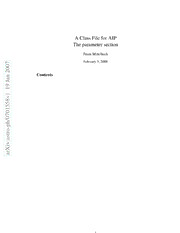
UVES - VLT High Resolution Spectroscopy of GRB Afterglows
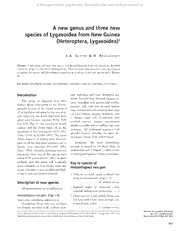
A new genus and three new species of Lygaeoidea from New Guinea (Heteroptera, Lygaeoidea)
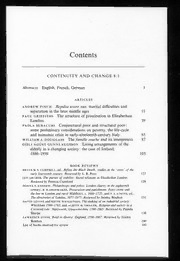
Continuity and Change 1993: Vol 8 Table of Contents
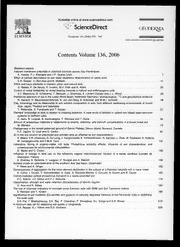
Geoderma 2006: Vol 136 Table of Contents

The God of that Summer
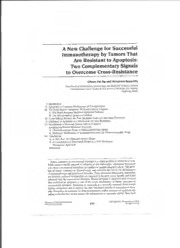
DTIC ADA593709: Regulation of TRAIL-Medicated Apoptosis in Prostate Cancer by Overexpression of XIAP

DTIC ADA450305: Central Asia and Its Asian Neighbors: Security and Commerce at the Crossroads

Insecticidal characteristics of the desert stingbush (Eucnide urens)
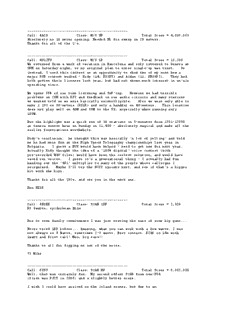
Call: 4A2S Class: M/S HP Total Score = 4839663 Absolutely no 10 mete

ERIC ED361046: Reinventing Teaching and Testing: Quality Learning for Quality Employment.

Caderno de Iniciação à Pesquisa Vol. 07

CAMPSITE IMPACTS AND THE LIMITS OF ACCEPTABLE CHANGE PLANNING PROCESS: A ...
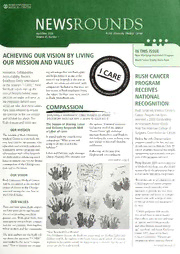
NewsRounds, 2006

04 - El último desafío
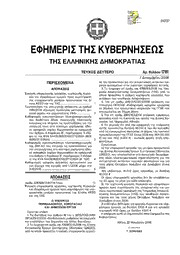
Greek Government Gazette: Part 2, 2006 no. 1781
